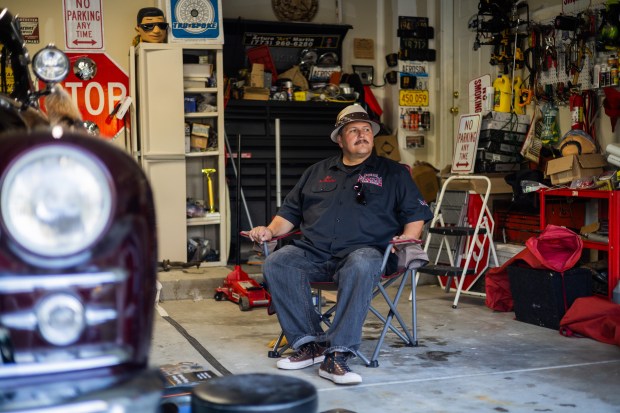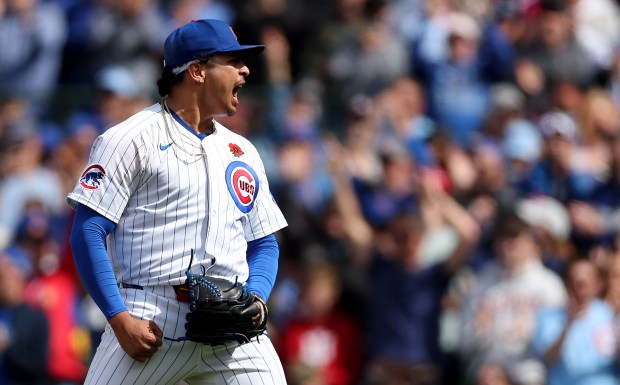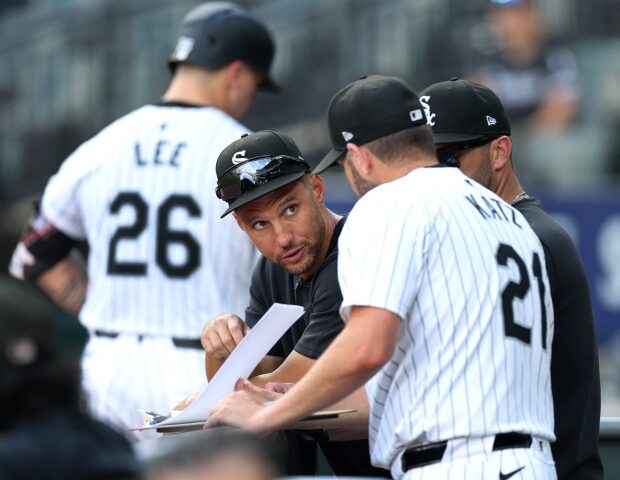Art Martin’s street is nothing too exciting, a suburban street in a subdivision of Shorewood, just like a lot of subdivisions on the outskirts of Chicago, surrounded by fields and strip malls. On Art Martin’s street, in the driveways of his neighbors, there are Toyota Siennas and Jeep Cherokees and Ford Explorers, most gray, white or light tan.
In Art Martin’s driveway sits a sort of answer, a 1947 Chevy Fleetmaster, painted kandy brandywine, with a little Corvette red thrown in. The curves go on for days. In fact, to get the paint job right on all those curls and hills, to get the proper depth to the color, Martin went through countless painters; it took him a decade to find the right one. There’s also a ’47 Cadillac in his garage, black cherry. He’s working on it, hood propped open with a rod, engine gleaming. He plans to unveil it next year. The grill alone — long metal teeth, like custom dentures for a dinosaur — is worth $5,000. And there, out on the street, his everyday ride, what he takes back and forth from work, that “stupid Escalade” of his. He says it with condescension. It’s a boring ride, considering.
Martin, 54, builds and collects lowriders.
Meaning, that culture of cars defined by lowered suspensions and chassis hovering inches off the street, sometimes bouncing cars, sometimes chassis that tilt precariously, an auto tradition largely created by the Mexican American communities of East Los Angeles and Texas, though for decades, nearly as healthy in Chicago. Martin’s ’47 Chevy, his ’47 Cadillac, are low. The tires are half-moons beneath fat fenders. Even his Escalade: Martin bought it 15 years ago and the first thing he did was lower the suspension.
“It’s an addiction,” he said, studying the Chevy.
“But the addiction part, for me, that means NOS — or what we call ‘new old stock.’ What I mean by that is when I buy parts to build these cars, I need brand new parts from back in the day. Not reproductions. New parts that are old, like still in their boxes.”
How common is that?
“Not common.”
Martin is far from alone in his obsession. This weekend, his ’47 Chevy will be shown and driven — along with hundreds of other local lowriders — at the 12th annual Slow&Low: Chicago Lowrider Festival at Navy Pier. The festival presents the lowrider as an American folk art, intrinsic to Hispanic heritage. Almost 80 local lowrider clubs attend. There’s El Barrio, Los Boulevardos, Chi-Town Riderz. There’s Wicked Life, Sick Life, Cold Life, Life’s 2 Low and Originales 4 Life. There are clubs with multiple chapters all across the country — Viejitos, Majestics, Dedication — that originated way out West.
Martin is vice president of Pura Familia — or pure family — a comparably small car club, founded in 2001, boasting just nine members, albeit with 40 lowriders between them. “Our motto is ‘Our cars are built, not bought,’” said David Espinoza, club president. “Anybody can look like a cowboy, but that doesn’t mean they are cowboys, you know?”
“We’re not about growing, either,” Martin said. “We’re about the lifestyle, the community, the people — the respect. We have one white person in the club who built this beautiful lowrider truck. When he asked to join, I was pretty surprised: ‘You know we’re Mexican American in this club?’ I asked. He said, ‘Yeah.’ Respect is the thing.”
Martin slides into his ’47 Chevy and it rumbles to life. On the center panel, where a lot of us have cup holders, he keeps a set of switches and gauges, used to raise and lower the car. Because it’s an older car, it’s not built to bounce, so raising and lowering are handled by totems of airbags that inflate and deflate. Newer lowriders go with hydraulics. Newer, as in cars first built in the ‘60s, ‘70s, ‘80s. When lowrider culture was in its nascent years, car builders pecked through scrap yards for airline hydraulics. “In the ‘60s especially, the earliest guys in this lifestyle, they created stuff, by trial and error,” Espinoza said. “Today, you’re going to pay ten times as much for all this as when I started. Now there’s a market! You can go online and just purchase the whole set-up.”
But most lowrider owners hunt, toil.
“My thing is to buy cars cheap and customize,” Espinoza said. “Sometimes it takes two years, sometimes five. Many of us just trick out something that is affordable, but you can’t imagine how much money goes in. Art went the high-end route with his Chevy.”
Martin, a former IT guy who now works for Laborers Union 76, stands in his driveway wearing black jeans, Converse All-Stars and a short-sleeve work shirt with “Pura Familia” stitched on the back. The trunk of his ’47 Chevy is a “Lucky 7” logo, a play on the Pixar “Cars” logo. There are two fluffy Canadian red fox tails attached to the frame. The interior is a peanut butter-colored leather. He says that he “went overboard.”
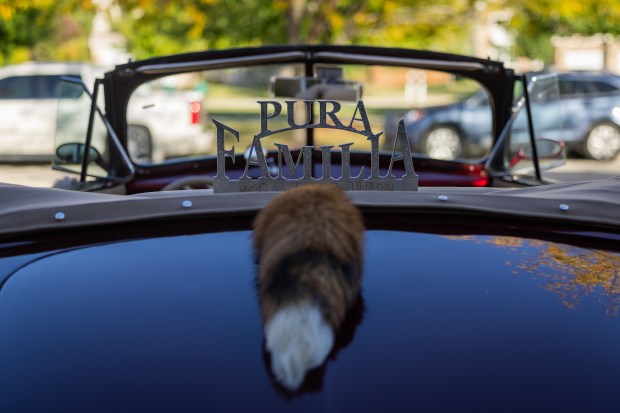
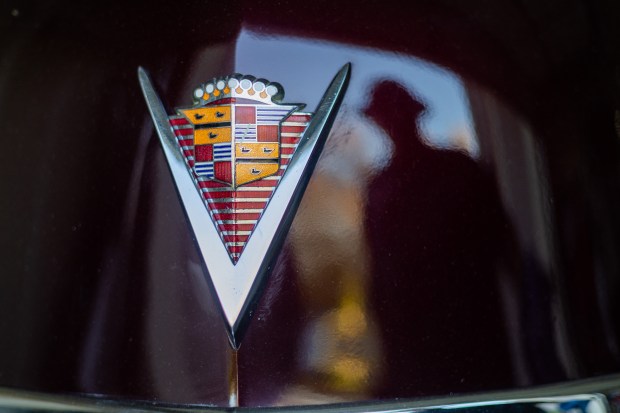
Though initially obsessed with ‘60s and ‘80s lowriders, as he got older he turned to “bombs,” or bombita, which is lowrider slang for an rounded older car (typically Chevy), the sort that early lowrider builders in Los Angeles worked on. Lowrider culture itself sprung to some extent from Mexican Americans who returned from the military with a lot of mechanical knowhow. It also came out of California for a couple of reasons: The size of the Mexican American population there and the sheer volume of used cars around Southern California, which, for decades, owned the most autos per capita in the nation.
The problem with bombs now is they’re old, expensive and parts are elusive. “I kind of screwed up with this one,” Martin said, looking at the ’47 Chevy. The frame alone cost him $25,000. The car also cost $25,000. Add the chrome, paint — he spent more than $100,000 on this Chevy alone. He became so obsessed with getting it right that he has a basement full of ‘Chevy parts. Enough to build two or three more.
And now he’s into ’47 Cadillacs.
Until the mid-‘80s, lowriders were rare in Chicago. Like Espinoza, when Martin began noticing them, it was around eighth grade, and his first love was a ’64 Impala. By the early ‘90s, Martin had finally built his own. “Soon as I started, I put weight in the car to drop it,” he said. “Sandbags, anything to drop (the chassis). With custom suspensions now, there’s no weight issue. When you have no money, you drop it however you can.”
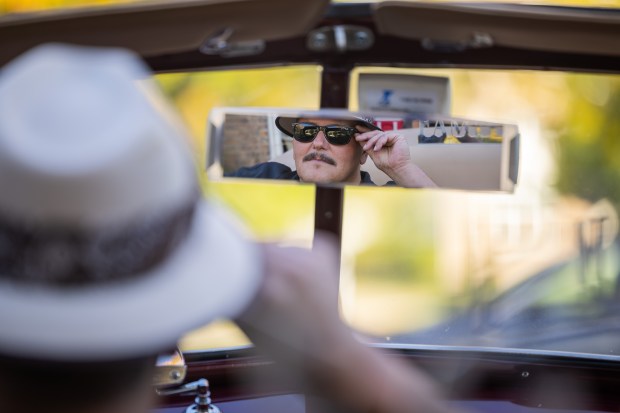
During the early days of Chicago lowrider culture, Espinoza said, “stereotypes were strong. You were Hispanic, it was assumed you drove certain car and were a drug dealer or a gang banger.” He’s owned the longtime West Town restaurant La Pasadita for decades. Martin recalls leaving the restaurant about 25 years ago, driving a lowrider and being stopped by a cop who was convinced they carried guns. “The gang unit came in. Cops are pointing guns. We didn’t have guns. We had a car. A cop impounds the car. He doesn’t give a reason. He drives off playing with the switches, raising and lowering. Anyway, we got lucky. A captain who worked part time at the restaurant helped. The cop threw the keys back at us. I haven’t been bothered by cops in years.”
The culture, and its focus on community and Hispanic roots, have edged closer to the mainstream. “These days,” Espinoza said, “I know cops who collect these cars, too.”
Their club, they say, is not even so much about cars anymore but belonging. It’s about the plaque they attach to a member’s lowrider, the one that just reads: “Pura Familia.”
Slow&Low will be 10 a.m. to 8 p.m. Oct. 12 at Navy Pier, 600 E. Grand Ave.; tickets are $15-$52 at at www.navypier.org
cborrelli@chicagotribune.com


